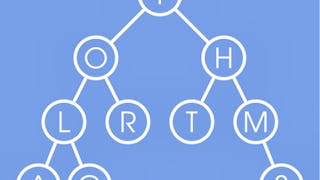How do Java programs deal with vast quantities of data? Many of the data structures and algorithms that work with introductory toy examples break when applications process real, large data sets. Efficiency is critical, but how do we achieve it, and how do we even measure it?

Gain next-level skills with Coursera Plus for $199 (regularly $399). Save now.

Data Structures and Performance
This course is part of multiple programs.



Instructors: Christine Alvarado
112,157 already enrolled
Included with
(2,243 reviews)
Skills you'll gain
Details to know

Add to your LinkedIn profile
16 assignments
See how employees at top companies are mastering in-demand skills

Build your subject-matter expertise
- Learn new concepts from industry experts
- Gain a foundational understanding of a subject or tool
- Develop job-relevant skills with hands-on projects
- Earn a shareable career certificate

There are 6 modules in this course
Welcome to the first module in the second course of our Intermediate Java Programming Specialization. We'll start with introductions again: to ourselves, the Google engineers, and the structure of the course. After the introduction we'll have a short warm up to get you comfortable with the code you will be building on to this class. But don't worry--no graded programming assignments yet. This week is all about getting comfortable and excited to learn.
What's included
7 videos9 readings3 assignments
This week we're going to dive into the course programming project. In the first lesson you'll learn about Strings and Regular Expressions, and in the programming assignment this week you'll apply that knowledge to adding functionality to your text editor so that it can measure the "readability" of text by calculating something called the "Flesch Readability Score". This course is focused on building code that not only does interesting things, but also finishes them quickly. So, let's get started building some code!
What's included
15 videos6 readings3 assignments1 programming assignment1 discussion prompt
Welcome to week 3! The text-editor application you worked with last week does something, but it doesn't do it particularly fast. This week we'll start talking about efficiency. We'll introduce the concept of "Big-O" notation, which sounds a little silly, but is really a powerful (and extremely common) way of analyzing a program's efficiency, independent of the system that it's running on and the exact details of how it's implemented. Then we'll go the other direction and dive into the details, talking about how to measure the actual running time of a piece of code to get an idea of how it really performs in practice.
What's included
25 videos3 readings4 assignments1 programming assignment
This week we'll start talking about some of the basic concepts that one expects to find in a data structures course: the idea of data abstraction, and a data structure called a Linked List. Even though Linked Lists are not very efficient structures (for the most part), they do hit home the idea of "linking" pieces of data together in your computer's memory, rather than storing the data in one contiguous region. This linking idea will be central to many of the more advanced data structures, namely trees and graphs, that are coming up later in this course and in the next course in this specialization. In this module you'll also learn tools and procedures for unit testing your code, which is a way to make sure that what you've written is correct, and a staple practice of any sophisticated software developer.
What's included
26 videos3 readings3 assignments2 programming assignments
Welcome to week 4! We know you've been working hard. We hope you tried that optional Markov Text Generation programming assignment last week, but if not, no worries. You can always go back and do it later (spoiler alert: it's pretty amazing that such a simple algorithm can produce such realistic text). This week there's more fun (and hard work) as we learn about trees. Trees rely on the same linked structure idea as Linked Lists, only they're MUCH faster (usually...). In the project this week you'll add auto-complete to your text editor. Believe us when we say it's so cool when you get it working! You'll see... and we bet you can't wait for the programming assignment now. :)
What's included
22 videos3 readings2 assignments1 programming assignment
You made it to the last week! Congratulations on getting this far! In this last week we'll be looking at a fundamental data structure called a Hash Table. If you thought trees were fast, just wait until you see what Hash Tables can do! Your last programming assignment will add spelling correction suggestions to your text editor, and there's an optional assignment that builds on the same ideas as the main assignment too, if you have the time and energy.
What's included
14 videos3 readings1 assignment2 programming assignments
Earn a career certificate
Add this credential to your LinkedIn profile, resume, or CV. Share it on social media and in your performance review.
Instructors



Offered by
Explore more from Algorithms
 Status: Free Trial
Status: Free Trial Status: Preview
Status: PreviewBirla Institute of Technology & Science, Pilani
 Status: Free Trial
Status: Free Trial Status: Free Trial
Status: Free TrialUniversity of California San Diego
Why people choose Coursera for their career




Learner reviews
2,243 reviews
- 5 stars
82.30%
- 4 stars
14.57%
- 3 stars
1.87%
- 2 stars
0.44%
- 1 star
0.80%
Showing 3 of 2243
Reviewed on Jan 16, 2017
A very good course for beginners , people having prior knowledge about data structures might found it a bit easy , anyways the projects were fun and was course was worth taking
Reviewed on Nov 19, 2017
Very helpful course in helping to understand data structures and algorithms. This course will certainly prepare me well for my university degree in computer science
Reviewed on Dec 26, 2015
Are you good at data structures ? If not, this will be the best course to start with. You learn the data structure and implement right away in your project assigment. Very practical.
Frequently asked questions
To access the course materials, assignments and to earn a Certificate, you will need to purchase the Certificate experience when you enroll in a course. You can try a Free Trial instead, or apply for Financial Aid. The course may offer 'Full Course, No Certificate' instead. This option lets you see all course materials, submit required assessments, and get a final grade. This also means that you will not be able to purchase a Certificate experience.
When you enroll in the course, you get access to all of the courses in the Specialization, and you earn a certificate when you complete the work. Your electronic Certificate will be added to your Accomplishments page - from there, you can print your Certificate or add it to your LinkedIn profile.
Yes. In select learning programs, you can apply for financial aid or a scholarship if you can’t afford the enrollment fee. If fin aid or scholarship is available for your learning program selection, you’ll find a link to apply on the description page.
More questions
Financial aid available,





